Last updated on July 14th, 2024 at 05:07 pm
Heredity And Evolution Notes
Below are some of the very important NCERT Class 10 Science chapter 9 Heredity And Evolution Notes and Question with Answers. These Class 10 Heredity And Evolution Notes and questions have been prepared by expert teachers and subject experts based on the latest syllabus and pattern of term 2. Questions with Answers to help students understand the concept.
These Questions for Class 10 Science Heredity And Evolution Notes and questions are very important for the latest CBSE term 2 pattern. These class 10 notes and Q and A are very important for students who want to score high in CBSE Board.
We have put together these NCERT Questions of Class 10 Science chapter 9 Heredity And Evolution Notes and questions with answers for practice on a regular basis to score high in exams. Refer to these Questions with Answers here along with a detailed explanation.
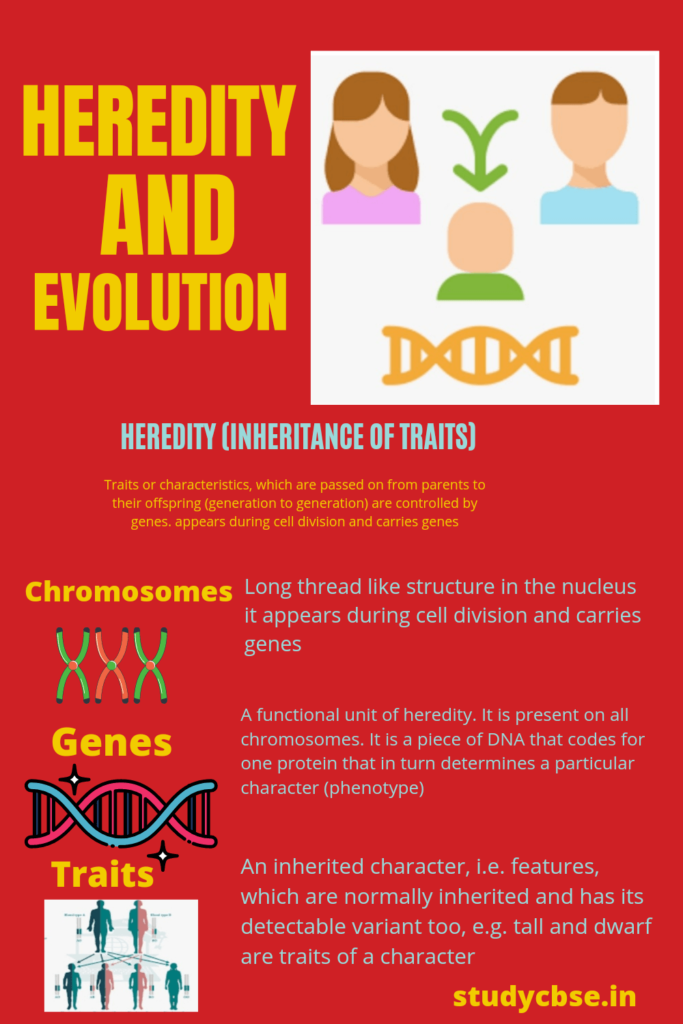

Through the process of reproduction individuals give rise to new individuals that are similar (not same) to the parents. This similarity in progeny or offspring or child is due to transmission of characters or traits from parents to their progeny.
The transfer of characters from parents to offspring is known as heredity and the process through which characters or traits pass from one generation to another is called inheritance.
Accumulation of Variations During Reproduction
The difference in the characters among the individuals of a species is termed as variations. These variations are accumulated by the process of sexual reproduction.
Depending upon the nature of variations, different individuals would have different advantages, the most important advantage of variation to a species is that it increases the chances of its survival in a changing environment.
Heredity (Inheritance of Traits)
Traits or characteristics, which are passed on from parents to their offspring (generation to generation) are controlled by genes.
A gene is a unit of DNA which governs the synthesis of one protein that constants a specific character of an organism.
e.g. Inheritance of free or attached earlobes


Rules of Inheritance of traits
Inheritance of a trait is related to the fact that both father and mother contribute equally towards the genetic makeup of their offspring
e.g. for each trait two versions are available in the child
Some Important Terms and definitions Used in Heredity
Chromosome. Long thread like structure in the nucleus it appears during cell division and carries genes
Genes. A functional unit of heredity. It is present on all chromosomes it is a piece of DNA that codes for one protein that in turn determines a particular character (phenotype)
Trait. An inherited character, i.e. features, which are normally inherited and has its detectable variant too, e.g. tall and dwarf are traits of a character, i.e. height.
Allele. One of the different forms of a particular gene, occupying the same position on a chromosome.
Hybrid. An individual having two different alleles for the same trait.
Dominant Allele. An allele, whose phenotype will be expressed even in the presence of another allele of that gene. It is represented by a capital letter, e.g. T.
Recessive Allele. An allele, which gets masked in the presence of a dominant allele and can only affect the phenotype in the absence of a dominant gene. It is represented by a small letter, e.g. t.
Genotype. Genetic composition of an individual.
Phenotype. The expression of the genotype, which is an observable or measurable characteristic.
Back cross. Crossing F1 hybrid with one of its parents, e.g. Tt × tt or Tt x TT.
Dihybrid cross. A cross in which inheritance of two pairs of contrasting characters is simultaneously studied.
Homozygous. A condition in which an individual possesses a pair of identical alleles controlling a given character and will breed true for this character (e.g. occurrence of two identical alleles for tallness in a P1 tall pea plant)
Heterozygous. A condition in which an individual has a pair of contrasting alleles for any one character and will not breed true for this character (e.g. simultaneous existence of dominant and recessive alleles in F1- hybrid tall pea plant).
Gametes. Reproductive cells containing only one set (haploid) of dissimilar chromosomes.
Test cross. Crossing F1 heterozygous with homozygous recessive parent, e.g. F1 hybrid tall plant (Tt) with pure dwarf plant (tt).
Mendel’s Contribution towards the Inheritance of Traits
The Austrian monk, Gregor Johann Mendel is known as Father of Genetics. He performed many experiments on pea (Pisum sativum) plants related to hybridisation.
He studied seven pairs of contrasting characters in pea plants and only one character at a time.
Click Below For All Class 10 Subjects Sample Papers 2024
Click Below To Learn Science Syllabus All Chapters
- Chapter 4: Carbon And Its Compounds Notes / Questions
- Chapter 5: Periodic Classification of Elements Notes / Questions
- Chapter 8: How Do Organism Reproduce Notes / Questions
- Chapter 9: Heredity And Evolution Notes / Questions
- Chapter 12: Electricity Notes / Questions
- Chapter13: Magnetic Effects of Electric Current Notes / Questions
- Chapter15: Our Environment Notes / Questions
Experiments Conducted By Mendel
More than a century ago, Mendel worked out the main rules for inheritance. He performed following two experiments
1. Monohybrid Cross : Inheritance of Traits for One Contrasting Character
- Mendel took pea plants with different characteristics such as height (tall and short plants).
- The progeny produced from them (F1-generation plants) were all tall. Mendel then allowed F1 progeny plants to undergo self-pollination.
- In the F2 -generation, he found that all plants were not tall, three quarters were tall and one quarter of them were short. This observation indicated that both the traits of shortness and tallness were inherited in F1-generation. But, only the tallness trait was expressed in F1 -generation.
- Two copies of the traits are inherited in each sexually reproducing organism


- In F2-generation, both the characters are recovered, though one of these is not seen in Fl stage. During gamete formation, the factor or allele of a pair segregate from each other,
Thus, the phenotypic ratio is 3 : 1 and the genotypic ratio is 1 ; 2 ; I for the inheritance of traits for one contrasting character, i.e. monohybrid cross.
2. Dihybrid Cross : Inheritance of Traits for Two Visible Contrasting Characters
- Mendel took pea plants with two contrasting characters, i.e. one with a green round seed and the other one with a yellow wrinkled seed,
- When the F1 progeny was obtained, they had round and yellow seeds, thus establishing that round and yellow are dominant traits,
- Mendel then allowed the F1 progeny to be self-crossed (self-pollination) to obtain F2 progeny. He found that seeds were round yellows, round green, wrinkled yellow and some were wrinkled green.
- The ratio of plants with above characteristics was 9 : 3 : 3 : 1, respectively (Mendel observed that two new combinations had appeared in F2)
In F2 generation all the four characters were assorted out independent of the other. Therefore, he said that a pair of alternating or contrasting characters behave independently of the other pair.
For example, seed color is independent of seed coat. The independent Inheritance of two separate traits shape and color of seeds is schematically shown below
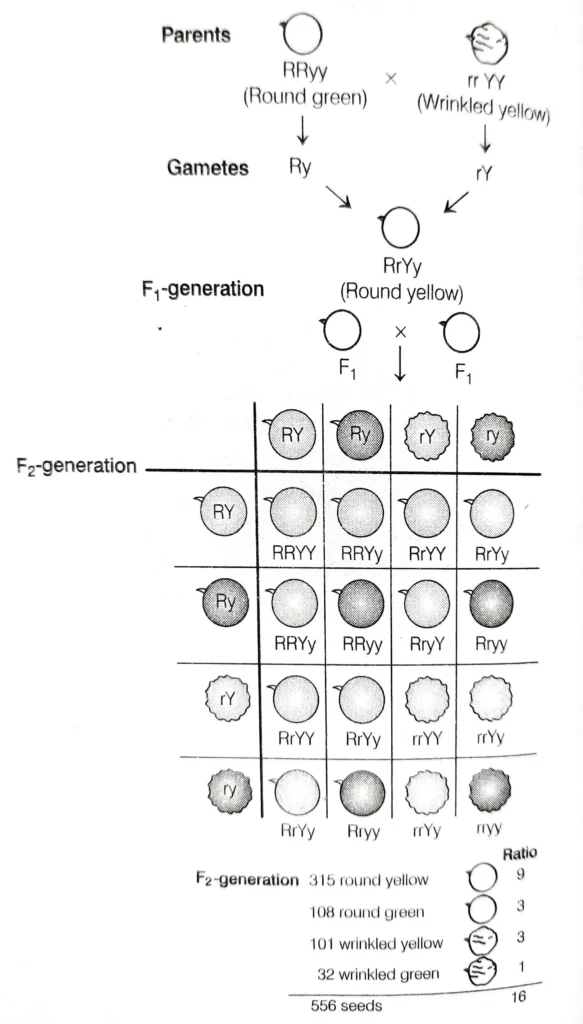

Expression of Trait
Cellular DNA is the source of information for making proteins in the cell. A section of DNA that provides information for one particular protein is called a gene for protein.
Expression of a trait in the body depends on the functioning of a gene. If the gene is working normally, sufficient protein will be produced for normal body functions.
If the gene for a specific protein is altered, the protein will less efficient or will not be functional at all,
Mechanism of Inheritance
- Both the parents contribute a copy of the same gene to their progeny. Each germ cell thus has one set of genes, present as a chromosome. Each cell of the body will have two copies of each chromosome, one inherited from each parent.
- When two germ cells combine, they restore the normal number of chromosomes in the progeny. This ensures the stability of the DNA of species. Such a mechanism of inheritance explains the result of Mendel’s experiments. It is used by all sexually and asexually reproducing organisms.
Sex-Determination
It is the process by which sex of a newborn individual is determined. Different strategies can determine sex in different species. For example, in reptiles environment factors such as temperature at which fertilised eggs are kept determine sex of the offspring.
The determination of sex occurs largely by genetic control in human beings. In human beings, there are 23 pairs of chromosomes, out of which 22 pairs are autosomes and one pair is sex-chromosomes.
Females have a perfect pair of sex chromosome (homogametic), but males have a mismatched pair (heterogametic) in which one is X (normal sized) and the other is Y-chromosome (shor! in size),
Hence, an egg fertilized by X-chromosome carrying sperm results in a zygote with XX, which becomes a female and if an egg is fertilized by Y-chromosome carrying sperm, it results in a XY zygote that becomes male,
Thus, the sex of the children will be determined by what they inherit from their father, A child who inherits an X-chromosome will be a girl and one who inherits a Y-chromosome will be a boy. The inheritance of sex in humans is diagrammatically shown, below:
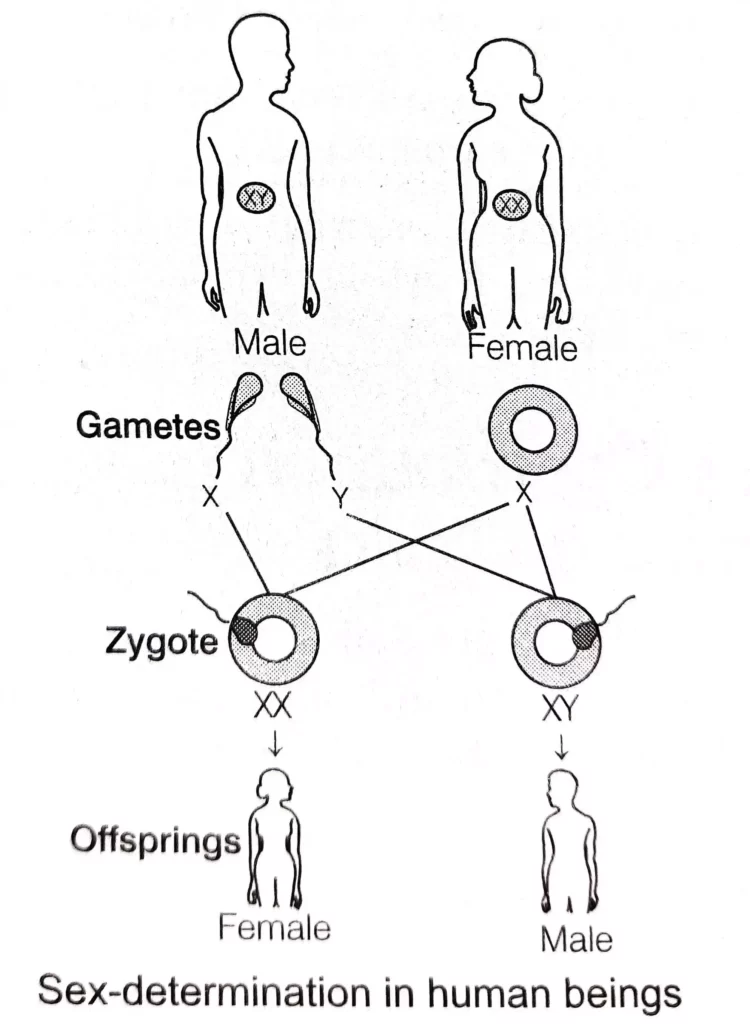

Frequently Asked Questions
Short Answer Type Questions
1. What do you mean by heredity? Who is its founder? (CBSE 2020)
Ans. The transmission of characters from the parents to their offspring is called heredity. Heredity was discovered by Gregor Mendel through his work on pea plants.
2. If a trait ‘A’ exists in 10% of the population of an asexually reproducing species and a trait ‘B’ exists in 60% of the same population, which trait is likely to have arisen earlier?
Ans. In a population of asexually reproducing species, the chances of appearance of new traits due to variations are very low and the trait which is already present in the population is likely to be in higher percentage and would have been arisen earlier.
Therefore, the trait B present in 60% of the population is the trait which has arisen earlier.
3. How does the creation of variations in a species promote survival?
Ans. During reproduction, copying of DNA takes place, which is not 100% accurate, thereby causing variations. If these variations are favorable, they help the individuals to survive and pass these variations to their progeny.
Depending upon the nature of variations, different individuals have different advantages, which promotes their survival like bacteria which can withstand heat will survive better in a heat wave.
4. In populations no two individuals are absolutely similar. Why?
Ans. Variations occur in the genes of the organisms produced due to the mutations, reshuffling of genes and inheritance of acquired traits during the evolutionary process which make all individuals different from one another. Thus, in any population, no two individuals are absolutely similar.
5. A child questions his teacher that why do organisms resemble their parents more as compared to grandparents. In which way, will the teacher explain to the child? (NCERT 2015)
Ans. The two parents involved in sexual reproduction produce gametes which fuse together forming a zygote. It gradually develops into n young child showing certain similarities with the, parents. Since, a child inherits its characters from both the parents, resemblance with them is very close.
The grandparents and the child resembles less closely because a gap of gene pool is created by the parents of the child
Variations of two generations mixing together and addition of new variations from parents, increases the difference between them to a greater extent. Silence, a child resembles more closely to its parents than the grandparents.
6. Why did Mendel choose a pea plant for his experiments?
Ans. Reasons for selecting pea plant for experiment by Mendel are as follows:
- Pea is an annual plant with a short life cycle, So, several generations can be studied in a short period.
- It produces bisexual flowers, which are mainly self-pollinating.
- It can be cross-pollinated.
- A number of contrasting characters were available in it.
7. How do Mendel’s experiments show that traits may be dominant or recessive? (CBSE 2016)
Ans. Mendel crossed a pure tall pea plant (TT) with pure dwarf pea plant (tt) and observed that all the progeny were hybrid tall (Tt), i.e. only one of the traits was able to express itself in the F1-generation, which is the dominant trait.
The other trait is called the recessive trait which remains suppressed.


The expressed trait T for tallness is the dominant trait, while the trait ‘t’ of dwarfness is recessive. Thus, Mendel’s experiments show that this trait may be dominant or recessive.
8. What do you mean by dominant and recessive characteristics?
Ans. Dominant character The character which will express in Fl -generation in both homozygous and heterozygous conditions are dominant characters.
e.g. Tallness of plant, purple flower color, etc.
Recessive character. The character which will express only in homozygous condition, but not in heterozygous conditions or in F1-generation is known as recessive character.
e.g. Dwarfness, white flower color, etc.
Click Below For All Class 10 Subjects Sample Papers 2024
9. Explain the difference between phenotype and genotype.
Ans.
| Phenotype | Genotype |
| it represent the external morphology of an organism for a particular characters | It is the genetic makeup of an individual for a character |
| Same phenotype may or may not belongs to same genotype | Same genotype produces same phenotype |
10. In a pea plant, find the contrasting trait if
(i) the position of flower is terminal
(ii) the flower is white in color
(iii) shape of pod is constricted (CBSE 2015)
Ans. Contrasting traits of pea plant were used by Mendel and were classified as or recessive.
Characters Given Traits Traits
Contrasting
(i) Position of flower Terminal Axial
(ii) Color of flower White Violet
iii) Shape of pod Constricted Full
11. How do Mendel’s experiments show that traits are inherited independently? (CBSE 2016)
Ans. Mendel performed a dihybrid cross between pure pea plants to show that traits are inherited independently. He selected a pea plant with round green (RRyy) and wrinkled yellow (rrYY) seeds.
In the F1 progeny, it was found that all plants were round yellow. But in F2 progeny, some plants were round green and some were wrinkled yellow.
However, there were plants which showed new combinations. Some of them were round with yellow seeds, while others were wrinkled with green seeds. Thus, the round/wrinkled trait and green/yellow seed traits are independently inherited.
12. In a certain species of animal black fur (B) is dominant over brown fur (b). Predict a genotype and phenotype of the offspring when both parents are Bb or have heterozygous black fur.
Ans.
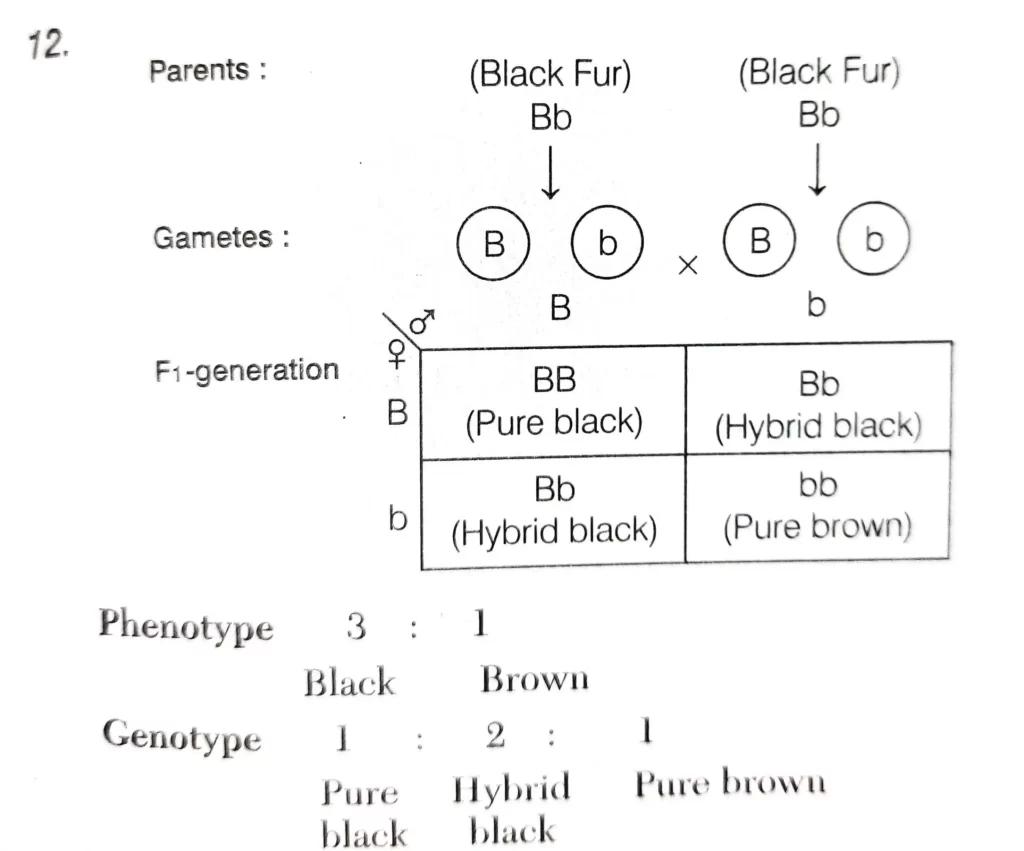

13. A man with blood group A married a woman with blood group O and their daughter has blood group O. Is this information enough to tell you which of the traits blood group A or O is dominant? Why or why not? (NCERT)
Ans. The information is insufficient to tell whether the trait ‘A’ or ‘O’ is dominant. It can be found by assuming the following cases.
In case I. Let assume that trait ‘A’ is dominant. Father has IAIO and mother has IOIO type of gene for blood group. In this case 50% of the progeny will have blood group A’ and 50% Of the progenies will have blood group ‘O’, when father’s blood group is IAIO and mother is lOIO
Whereas, in case of father having IAIA type of gene and mother having IOIO type of gene, all of the progeny (100%) will have blood group A.
In case II. Let assume that ‘O’ is dominant in this case, the child may have blood group ‘O’. Since in both the assumptions that a child can have blood group it cannot infer which trait is dominant.
14. Write the phenotypic ratio of progeny ofF2-generation of a dihybrid cross. (2018, 15)
Ans. When pea plants with two contrasting characters, i.e, one with a green round seed and the other with a yellow wrinkled seeds are crossed, all the F1 progeny obtained had round and yellow seeds.
When the F1 progeny is self-crossed to obtain F2 progeny, four types of seeds were obtained as round yellow, round green, wrinkled yellow and wrinkled green in ratio 9 : 3 : 3 : I respectively.
Hence, the phenotypic ratio of F2 progeny is 9 : 3 : 3 : 1
15. Consider the cross between two parents with contrasting characteristics given below.


Recompile the above observations and explain the law of inheritance associated with them.
Ans. Mendel took pea plants with two contrasting characters, i.e. one with green round seeds and the other with yellow wrinkled seeds.
When the Fl progeny was obtained, they had round and yellow seeds. Mendel then allowed the Fl progeny to be self-crossed to obtain F2 progeny.
He found that seeds were round yellow, round green, wrinkled yellow and some were wrinkled green. The ratio of plants with above characteristics was 9 : 3 : 3 : 1, respectively.
In F1-generation, all the characters were asserted independently of each other. Therefore, he stated that a pair of contrasting or alternating characters behave independently of the other pair.
16. Name the plant Mendel used for his experiments.
What progeny was obtained by Mendel F1 and F2 generations when he crossed the tall and short plants? Write the ratio he obtained in F2-generation plants. (CBSE, Delhi)
Ans. Mendel used the pea plant for his experiments. He took pea plants with different characteristics such as height (tall and short plants). The progeny produced from them (FL-generation) plants were all tall.
Mendel then allowed Fl progeny plants to undergo self pollination. In the F2-generation, he found that all plants were not tall, three quarters were tall and one quarter of them were short. The ratio he obtained in F2-generation plants are 9 : 3 : 3 : 1.
17. Study the following cross showing self-pollination in Fl progeny. Fill in the blank and answer the questions that follow.
RRyy × rrYY Parents
(Round green) (Wrinkled yellow)
RrYy × RrYy F1-generation
(Round yellow) (Round yellow)
(i) In the above question, what is the combination of characters in the F2 progeny? What are the ratios?
(ii) Give reasons for the appearance of new combinations of characters in the Fl progeny. (NCERT Exemplar)
Ans.
(i) In F1-generation, the combination of characters is
Round yellow = 9, Round green = 3
Wrinkled yellow = 3, Wrinkled green = 1
Thus, the ratio is 9 : 3 : 3 : 1
(ii) In F1-generation, the production of all round yellow (RrYy) seeds explains that the round shape and yellow color of the seeds were dominant traits over the wrinkled shape and green color of the seeds which segregated during F2-generation.
18. How is the sex of a child determined in human beings?
Ans. A male gamete carries either one X or one Y-chromosome, while a female gamete carries only X-chromosomes. Therefore, sex of the child depends upon what happens during fertilisation.
(i) If a sperm carrying X-chromosome fertilizes the egg, the child born will be a female (XX).
(ii) If a sperm carrying Y-chromosome fertilizes the egg, the child born will be a male (XY).
Thus, the sperm (the male gamete) determines the sex of the child.
19. Does genetic combination of mother play a significant role in determining the sex ofa newborn? (NCERT Exemplar)
Ans. No, the genetic combination of mother does not play any significant role in determining the sex of a newborn. This is because the female cell carries two X-chromosomes (XX).
While, the male cell carries one X and one Y-chromosome. The fusion of X-chromosome bearing sperm (of male cell) with X-chromosome of female egg produces a female child, while the fusion of Y-chromosome bearing sperm (of male cell) with X-chromosome of female egg produces a male child. Therefore, it is the contribution of father which determines the sex of a newborn.
Long Answer Type Questions
20. ‘A trait may be inherited, but may not be expressed’. Justify this statement with the help of a suitable example.
Ans. ‘A trait may be inherited, but may not be expressed’. Mendel crossed tall pea plants with dwarf pea plants.
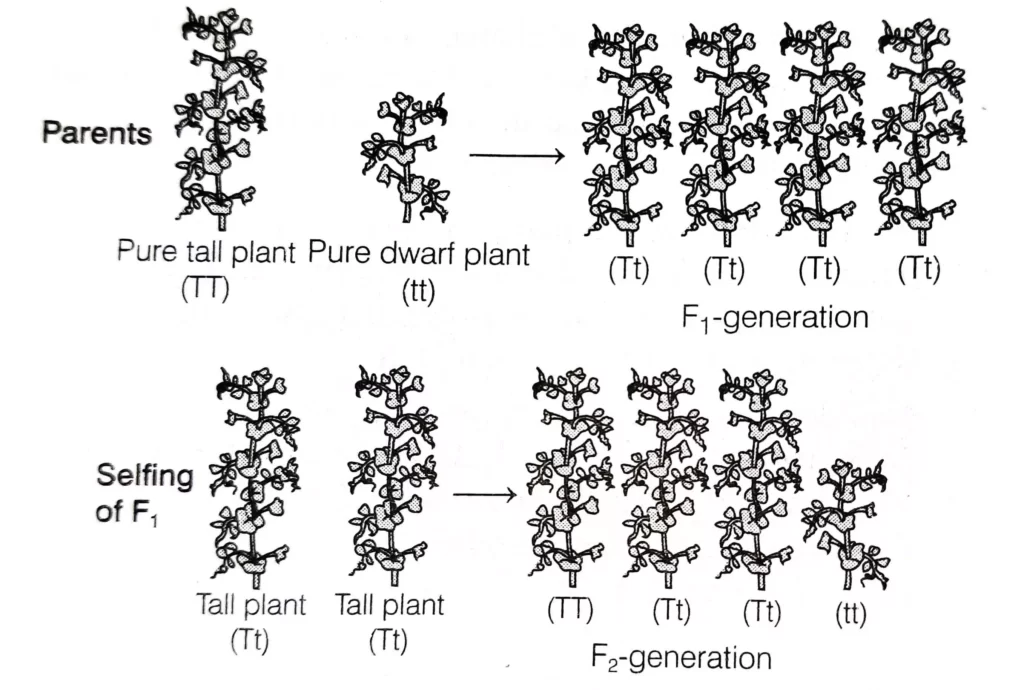

Mendel’s observation F1-generation contained all tall plants with genotype Tt, where ‘T’ represents a dominant trait and ‘t’ represents a recessive trait. This means when the F1-generation underwent selfing, the trait that was unexpressed in F1 (dwarf) was observed in some F2-progeny. Thus, both traits, tall and dwarf, were expressed in F2- generation in the ratio of 3 : 1.
21. Discuss Mendelian laws with examples.
Ans. The three major laws of inheritance proposed by Mendel are as follows:
(i) Law of Dominance (First Law). According to this law, when two homozygous individuals with one or more contrasting characters are crossed, the hybrid have both the contrasting alleles of a pair, but only one (i.e. dominant trait) allele expresses and it does not allow the other one (recessive trait) to appear.


(ii) Law of Segregation or Law of Purity of Gametes (Second Law).
This law states that the factors or alleles of a pair segregate from each other during gamete such that a gamete receives only one of the two factors.
They do not show any blending.
e g. The reappearance of wrinkled seed character in F2-generation, which was suppressed in F2-generation by the round seed characters.
This law is also proven by monohybrid cross.
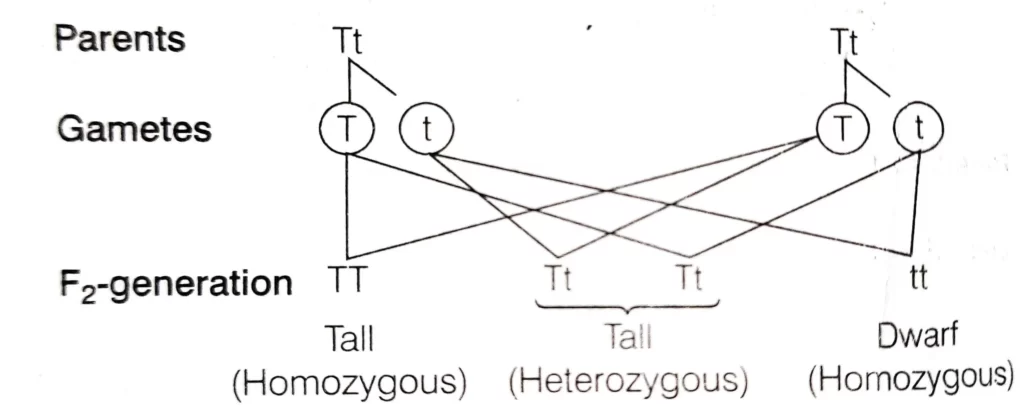

(iii) Law of Independent Assortment (Third Law) This law states that two factors of each character assort or separate the time of gamete formation and get randomly rearranged in the offspring.
e.g. In a dihybrid cross, between pure round and yellow seed pea plants with plants having wrinkled and green seeds, the F2-generation produced two parental and two hybrid combinations.
This law can be proven by dihybrid cross


22. What do you understand about Mendel’s dihybrid cross? When pea plants having round and yellow seeds were crossed with plants having wrinkled and green seeds and then all the plants of F 1 -generation had round and yellow seeds. Find out the phenotypic ratio of F2 -generation.
Ans. Dihybrid Cross. When a cross between two varieties having contrasting characters takes place, then it is called dihybrid cross.
In the F1-generation, on the basis of the law of dominance, only dominant characters appear. During gamete formation, genes of contrasting characters separate and only one gene enters gamete.
On self-fertilization, the F1-generation develops F2-generation in which 9 : 3 : 3 : 1 phenotypic ratio appears.
In the F2-generation, a new combination also develops.
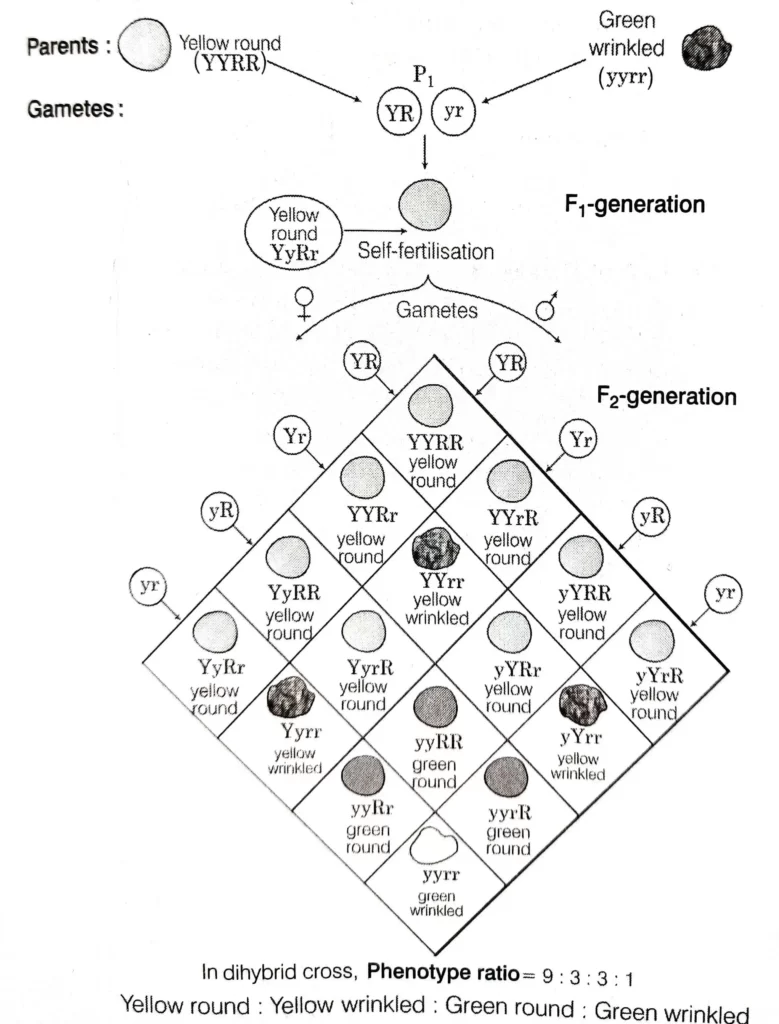

23. After self-pollination in pea plants with round, yellow seeds, following types of seeds were obtained by Mendel
Seeds Numbers
Round, yellow 630
Round, green 216
Wrinkled, yellow 202
Wrinkled, green 64
Analyze the result and describe the mechanism of inheritance which explains these results. (CBSE 2020)
Ans. In dihybrid cross, the ratio of phenotype of F2-generation obtained by selfing of F1-generation is 9 : 3 : 3 : 1, in which parental as well as new combinations are observed.
This shows the law of independent assortment in which two characters under consideration assort in an independent manner to give rise to different combinations.
It means that the genes of all the characters are independent from each other and combined to make new varieties.
24. ‘In humans, there is a 50% probability of the birth of a and 50% probability that a girl will be born’. Justify the statetnent on the basis of the mechanism of sex-determination in human beings. (CBSE 2020)
Ans. Humans have 23 pairs of chromosomes. Both male and female carry two sets of sex chromosome.
Male (XY) has one X and one Y sex chromosome. Female (XX) has both X sex chromosome.
All children will inherit an X-chromosome from their mother regardless of whether they are boys or girls.
Thus, the sex of the children will be determined by what they inherit from their father. A child who inherits an X-chromosome from her father will be a girl and one who inherits a Y-chromosome from him will be a boy.
Click Below For All Class 10 Subjects Sample Papers 2024
Case Based Questions
25. Read the following and answer the questions from (i) to (v) given below
Inheritance from the previous generation provides both, a common body design and subtle changes in it, for the next generation.
Now, when the new generation reproduces, the second generation produced will have variations that they inherit from the first generation, as well as newly created differences.
For example, if one bacterium divides and gives rise to two individuals each of them will divide again and give rise to two other individuals in the next generation.
The four individual bacteria generated would be very similar with minor differences that occurred due to small inaccuracies to copying of DNA.
However, in sexual reproduction, even greater diversity will be generated. Depending upon the nature of variations, different individuals would have different advantages, the most important advantage of variation to a species is that it increases the chance of its survival in a changing environment.
(i) What do you understand by the term ‘gene’ ?
(ii) In which type of reproduction exchange of genetic material takes place ?
(iii) What is the cause of variation in asexual reproducing organisms ?
(iv) Differentiate between genotype and phenotype of an organism.
(v) What is the chemical composition of chromosomes ?
Ans.
(i) A gene is a unit of DNA which governs the synthesis of one protein that provides a specific character of the organisms.
(ii) Exchange of genetic material takes place in sexual reproduction.
(iii) Environmental factors and mutations cause variation in asexual reproducing organisms.
(iv) The genetic constitution of an organism is called genotype, whereas the phenotype is the physical appearance or characteristics of the organism.
(v) The chemical composition of a chromosome is DNA and histone proteins.
26. Read the following and answer the questions from (i) to (v) given below
A person first crossed pure-breed pea plants having round-yellow seeds with pure-breed pea plants having wrinkled-green seeds and found that only A-B hoe of seeds were produced in the Fl -generation.
When F1-generation pea plants having A-B type of seeds were cross-breed by self-pollination, then in addition to the original round yellow and wrinkled-green seeds, two new varieties A-D and C-B types of seeds were also obtained,
(i) What are A-B types of seeds?
(ii) State whether A and B are dominant traits of recessive traits.
(iii) What are A-D types of seeds?
(iv) What are C-B type of seeds?
(v) Out of A-B and A-D types of seeds, which one will be produced in (a) minimum number and (b) maximum number in the F2 -generation?
Ans. (i) A-B type of seeds are round in shape and yellow in color as round and yellow both constitute the dominant character, hence expressed in F1-generation.
(ii) A(round) and B(yellow) are dominant traits.
(iii) Round-green (A-D).
(iv) Wrinkled-yellow (C-B).
(v) (a) A-D in minimum number.
(b) A-B in maximum number.
27. Read the following and answer the questions from (i) to (v) given below
Mendel selected garden pea for his experiments because he discovered for the first time the occurrence of two types of seeds in pea plants growing in the garden of his monastery. Mendel then used a number of contrasting visible characters of garden peas like :


Mendel’s experiments were performed in three stages in selection of pure or true breeding parents, hybridisation and obtaining of F1-generation of plants and self-pollination of hybrid plants and raising of subsequent generations like F2, F3, F4, etc.
(i) How many contrasting traits were taken by Mendel in his monohybrid crosses?
(ii) Give a monohybrid cross to explain the F1 -generation formed by a plant with green pod
color and yellow pod color.
(iii) State the first law of Mendel.
(iv) What are homozygous tall plants and heterozygous tall plants?
(v) A Mendelian experiment consisted of breeding pea plant bearing violet flowers with pea plants bearing while flowers. What will be the results in Fl progeny?
Ans. (i) One contrasting trait, i.e. tall and dwarf plants were taken by Mendel in his monohybrid crosses.
(ii)
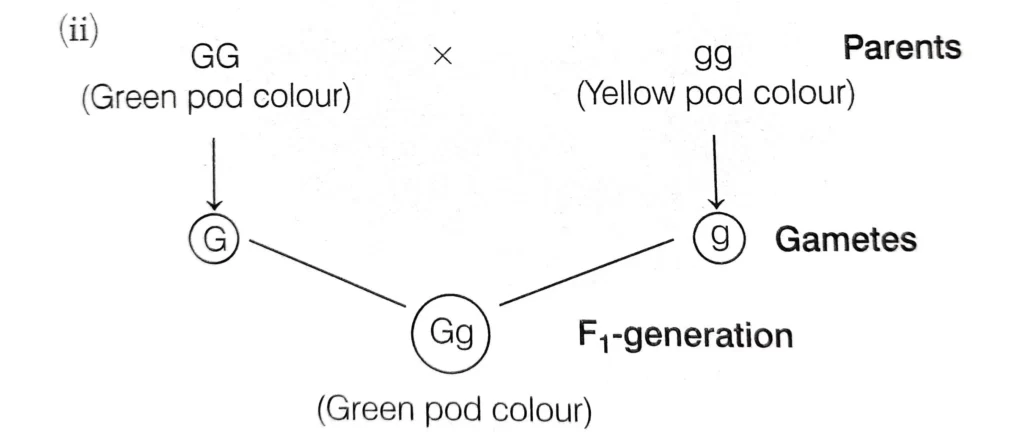

(iii) The first law of Mendel is law of dominance, which states that when two alleles of an inherited pair are heterozygous, then the allele that is expressed is dominant, whereas the allele that is not expressed is recessive.
(iv) Homozygous tall plants will have two identical copies of a single gene. i.e. TT
Heterozygous tall plant will have two different copies of a single gene. i.e. Tt
(v) Heterozygous pea plants with violet flowers will result in FL-progeny
28. Read the following and answer the questions from (i) to (v) given below
Observe the following cross between tall plants having round seeds and dwarf plants having wrinkled seeds.
The individuals obtained in the Fl -generation were thereafter self-crossed.
TTRR × ttrr
(Tall, Round) (Dwarf, Wrinkled)
TtRr x TtRr (F1-generation self-crossed)
(Tall, Round) (Tall, Round)
(i) What would be the phenotypes of the individuals obtained in the F2 -generation? Give their ratios.
(ii) Why do you think all the individuals of the Fm-generation were tall with round seeds?
(iii) What will be the number of progeny obtained in F2 -generation in a dihybrid cross with pure dominant traits?
(iv) What would be the phenotype of the individual obtained in F1 -generation?
(v) According to you, what is responsible for the inheritance of traits?
Ans. (i) In F2-generation the phenotypes of the individuals obtained would be
Tall and round = 9; Tall and wrinkled = 3;
Dwarf and round = 3;
Dwarf and wrinkled = 1
Thus, the ratio is 9 : 3 : 3 : 1.
(ii) The appearance of all tall plants with round seeds shows that the tallness and round-shaped seeds are dominant traits over the dwarfness and wrinkled shape of the seeds.
(iii) The number of progeny obtained in F2-generation in a dihybrid cross with pure dominant traits, i.e. TTRR will be 1 which is formed by the fertilization of gametes
(iv) In the F1-generation, all tall and round plants will be obtained.
(v) Gene is the carrier that leads to the inheritance of traits. It is the part of a chromosome that controls the appearance of a set of hereditary characteristics.
29. Read the following and answer the questions from (i) to (v) given below
A person crossed pure-breed tall pea plants with pure-breed dwarf pea plants and obtained pea plants of F1-generation. He then performed two types of experiments.
In the first, he self-crossed the plants of F1 -generation (experiment A) and in the second, he crossed the plants of F1 -generation with the pure-breed dwarf parent plants (experiment B).
Experiment A : F1 progeny × Fl progeny
Experiment B : F1 progeny × Homozygous dwarf plant
(i) What would be the phenotype of plants in the Fl -generation ?
(ii) What would be the phenotype and genotype ratio of F2-generation in experiment ‘A’?
(iii) How would the genotypic ratio in F2 generation be different in experiment ‘B’?
(iv) How do we describe the phenotypic character that is expressed in Fl -generation? What is the term given to the contrasting character?
(v) Name the type of cross shown in experiment B.
Ans. (i) The phenotype of all the plants in the F1-generation would be tall.
(ii) In experiment ‘A’, the phenotypic ratio of tall and dwarf plants would be 3 : 1 : : Tall : Dwarf, whereas the genotypic ratio would be 1 : 2 : 1 for TT, Tt, tt genotype.
(iii) When crossed with a homozygous recessive parent the genotypic ratio would be 1 : 1 for Tt, tt genotype.
(iv) The phenotypic character that is capable of expressing in the F1-generation is described as ‘dominant’. The contrasting character, i.e. dwarfness is the recessive character.
(v) In experiment B, test cross is done between the heterozygous with homozygous recessive parent.
Click Below For All Class 10 Subjects Sample Papers 2024
Click Below To Learn Science Syllabus All Chapters
- Chapter 4: Carbon And Its Compounds Notes / Questions
- Chapter 5: Periodic Classification of Elements Notes / Questions
- Chapter 8: How Do Organism Reproduce Notes / Questions
- Chapter 9: Heredity And Evolution Notes / Questions
- Chapter 12: Electricity Notes / Questions
- Chapter13: Magnetic Effects of Electric Current Notes / Questions
- Chapter15: Our Environment Notes / Questions
Final Words
From the above article, you have practiced Class 10 chapter 9 Heredity And Evolution Notes and questions. We hope that the above-mentioned notes and Q & A for term 2 will surely help you in your exam.
If you have any doubts or queries regarding Class 10 chapter 9 Heredity And Evolution Notes and questions with Answers, feel free to reach us and we will get back to you as early as possible.
Click Below To Learn 10 Science
Syllabus Chapter wise MCQs